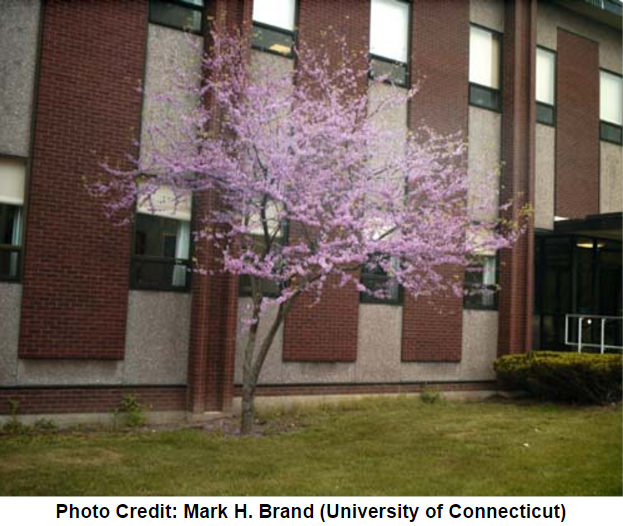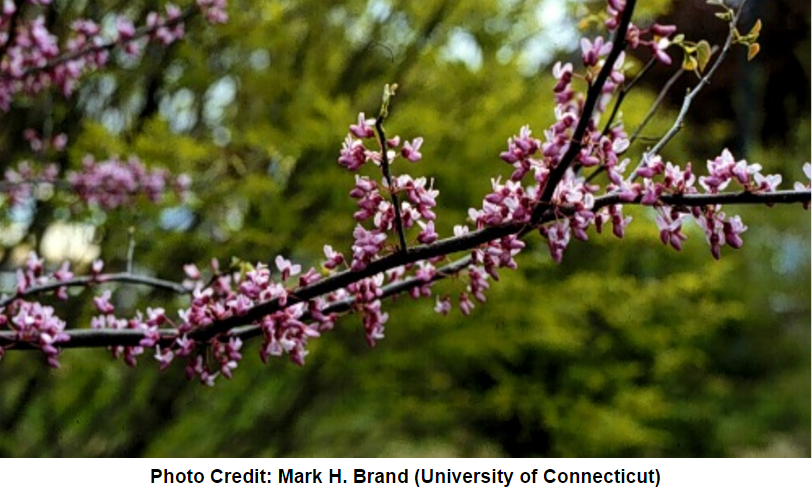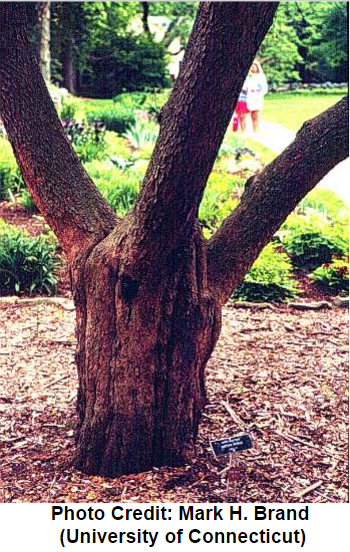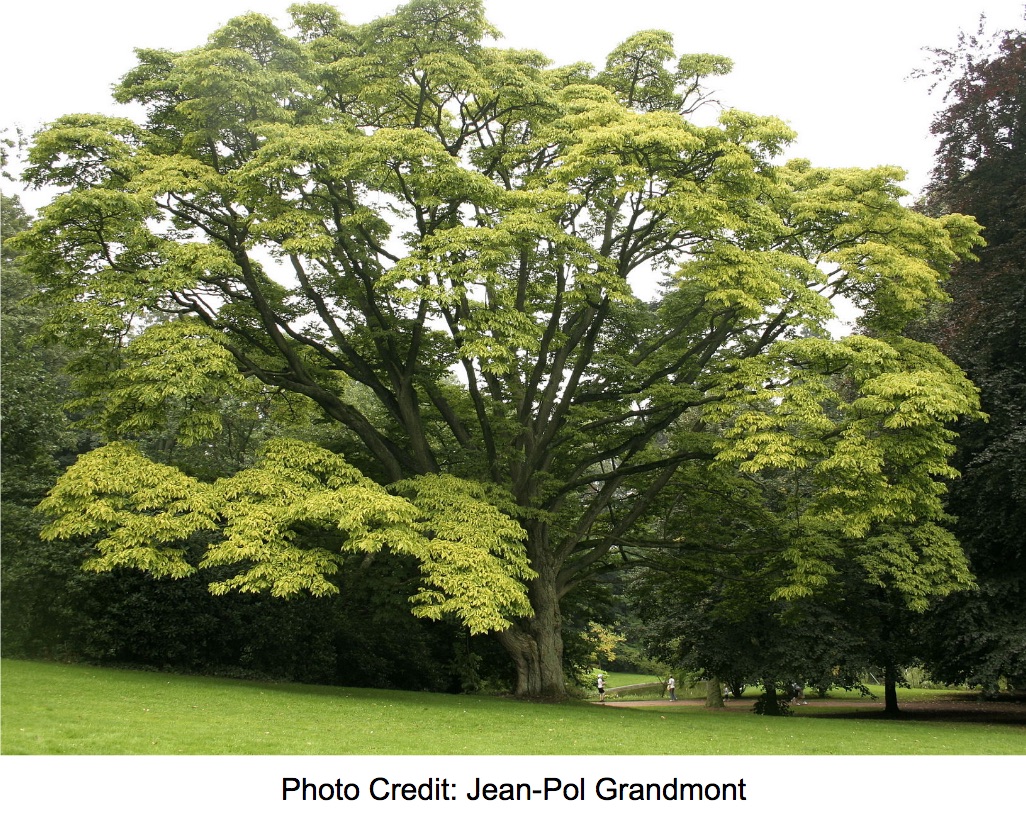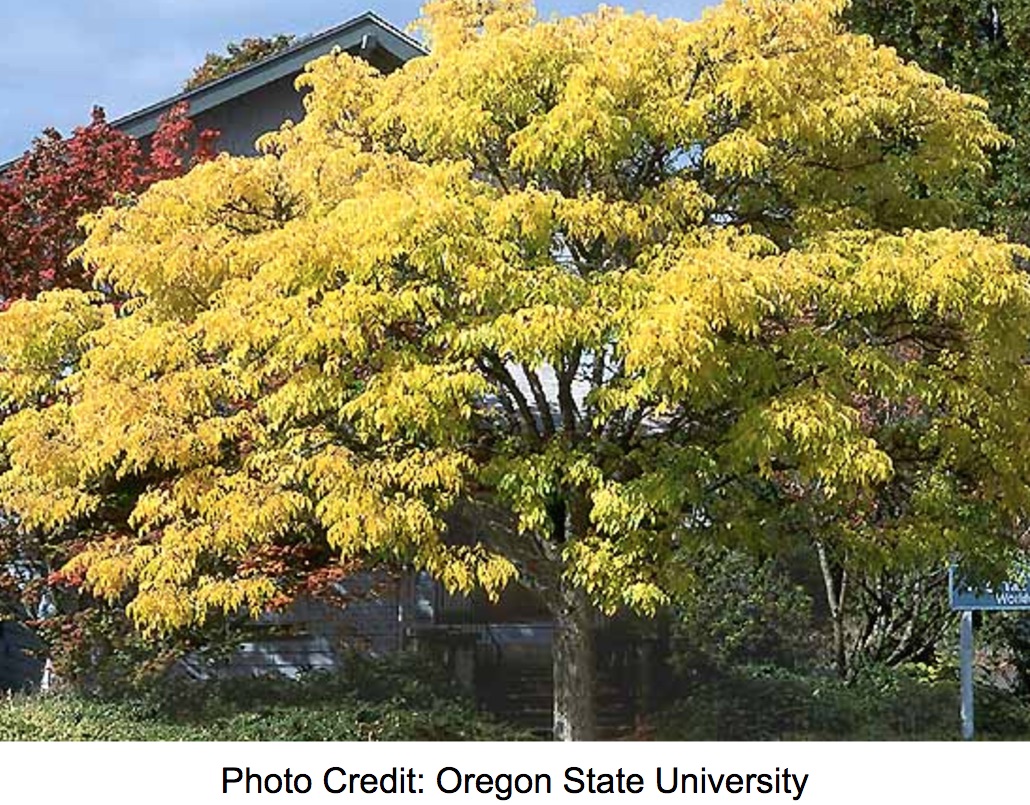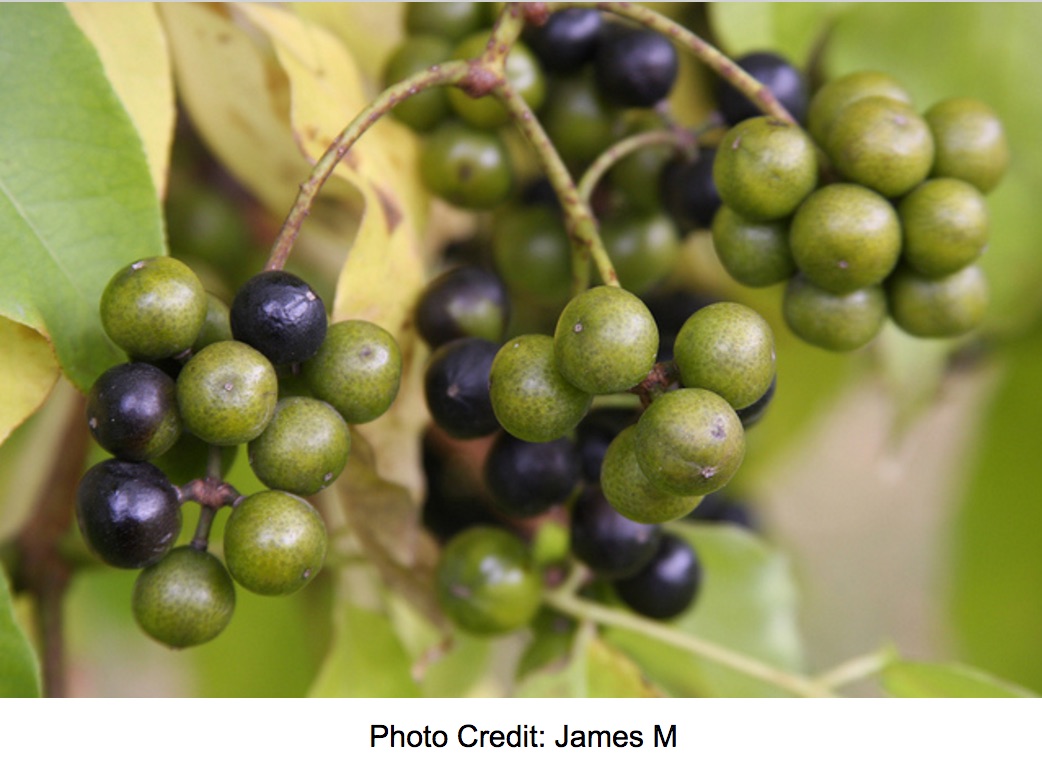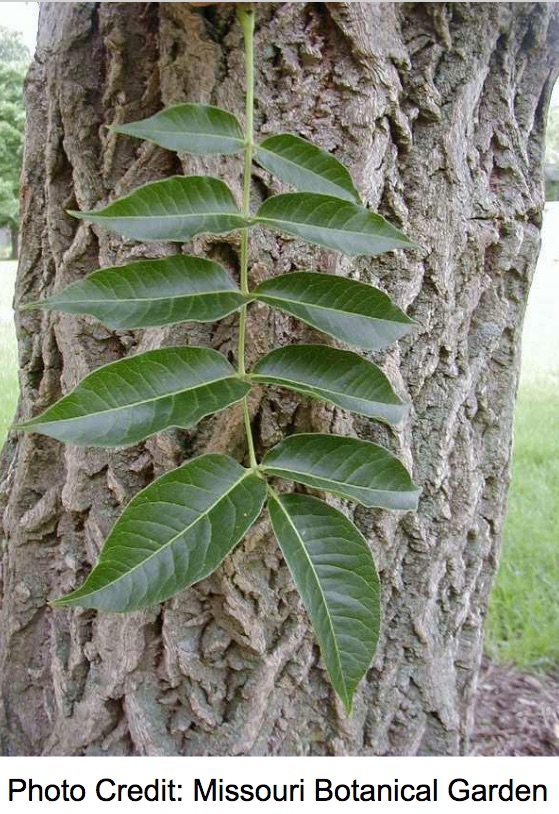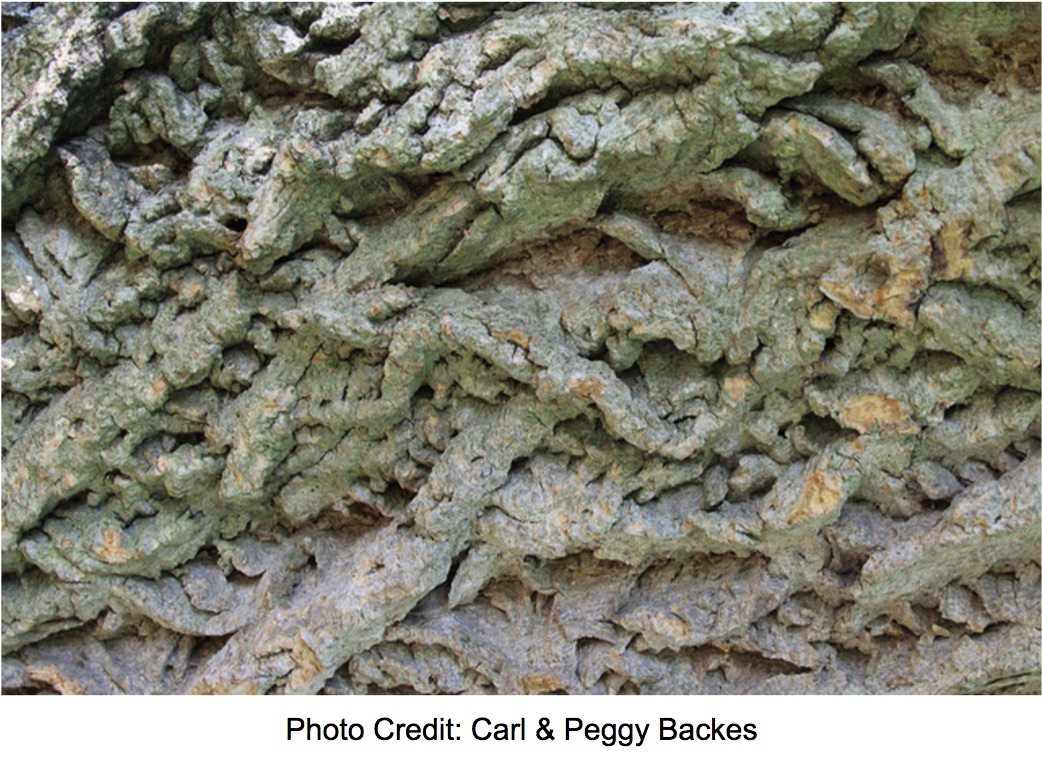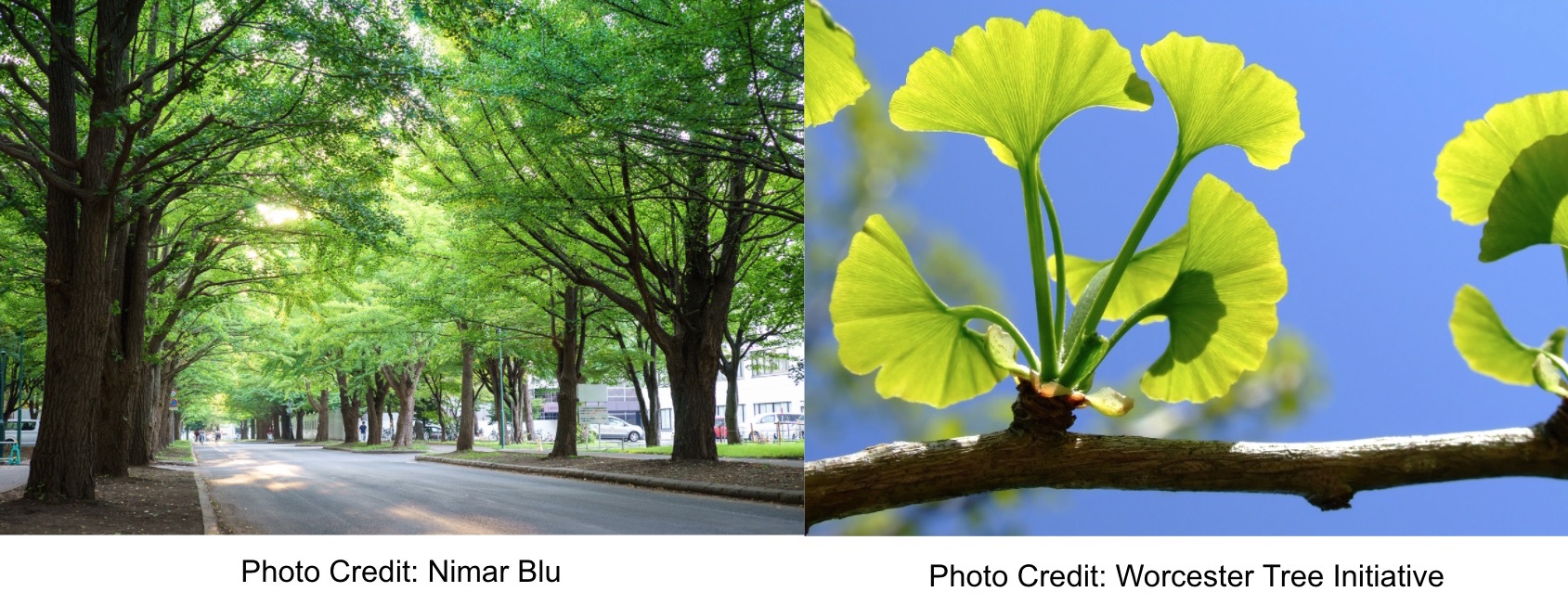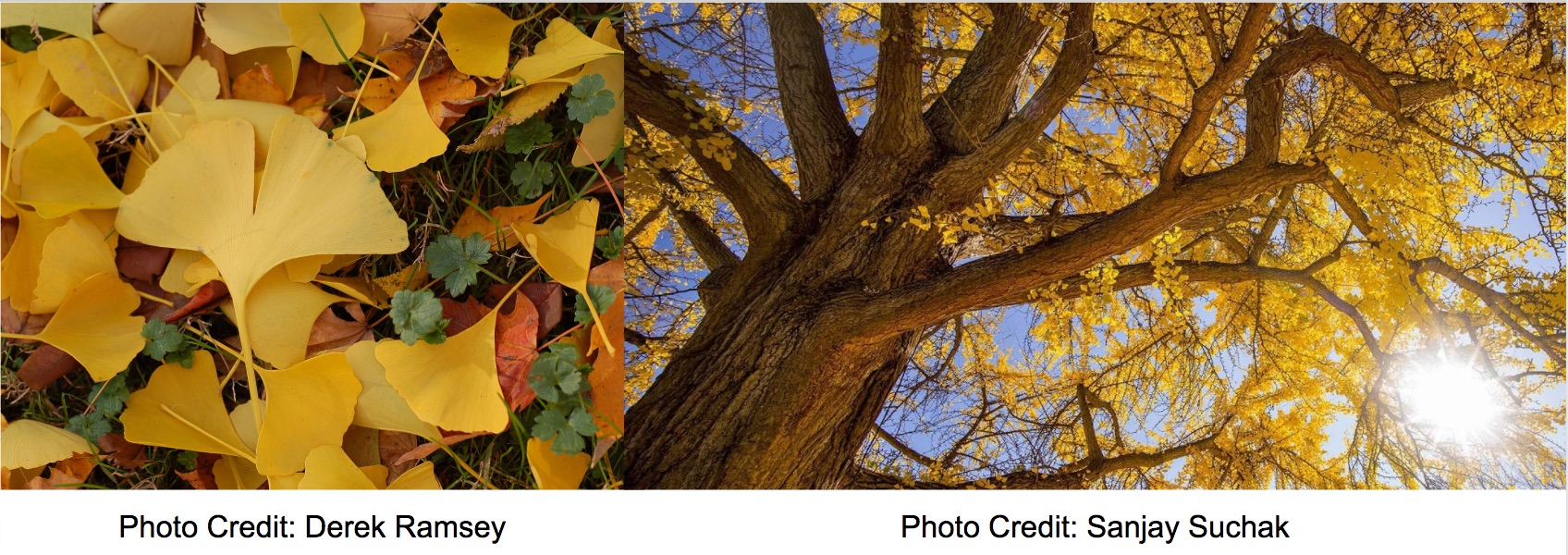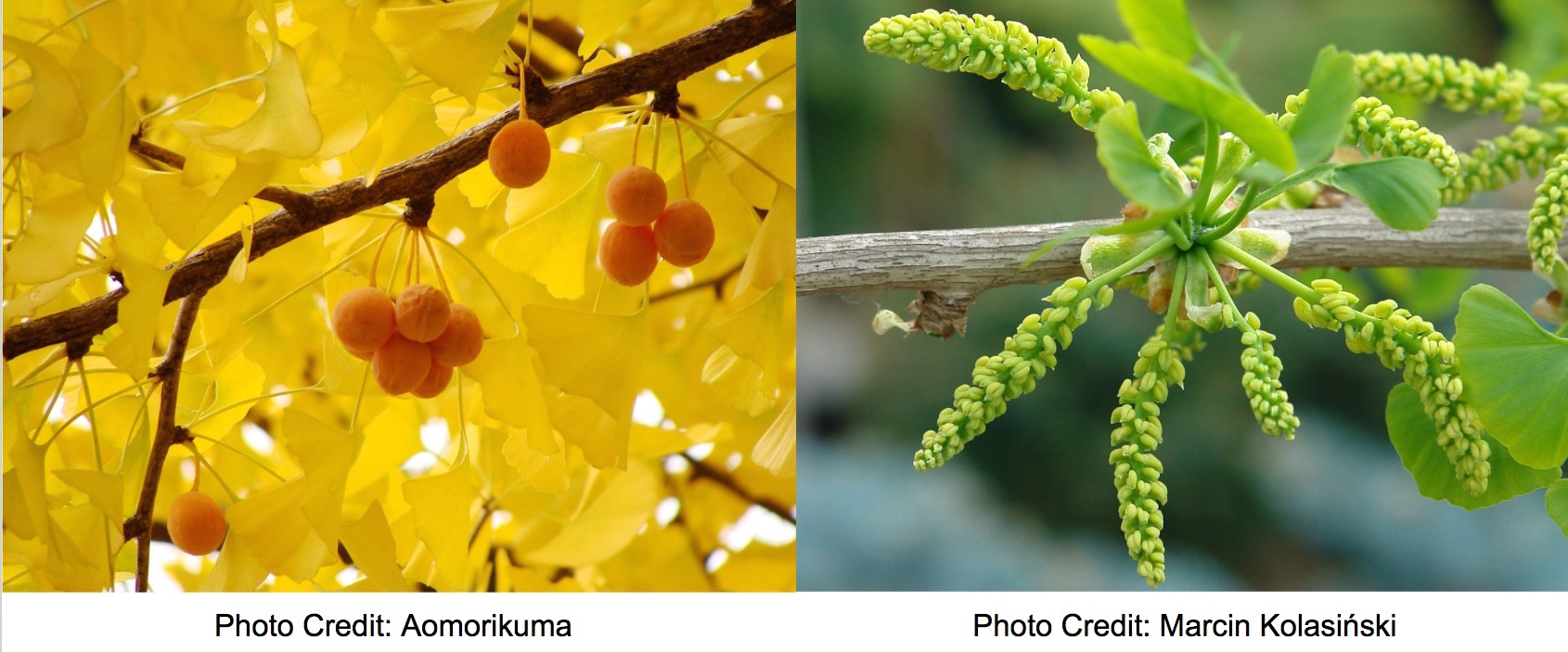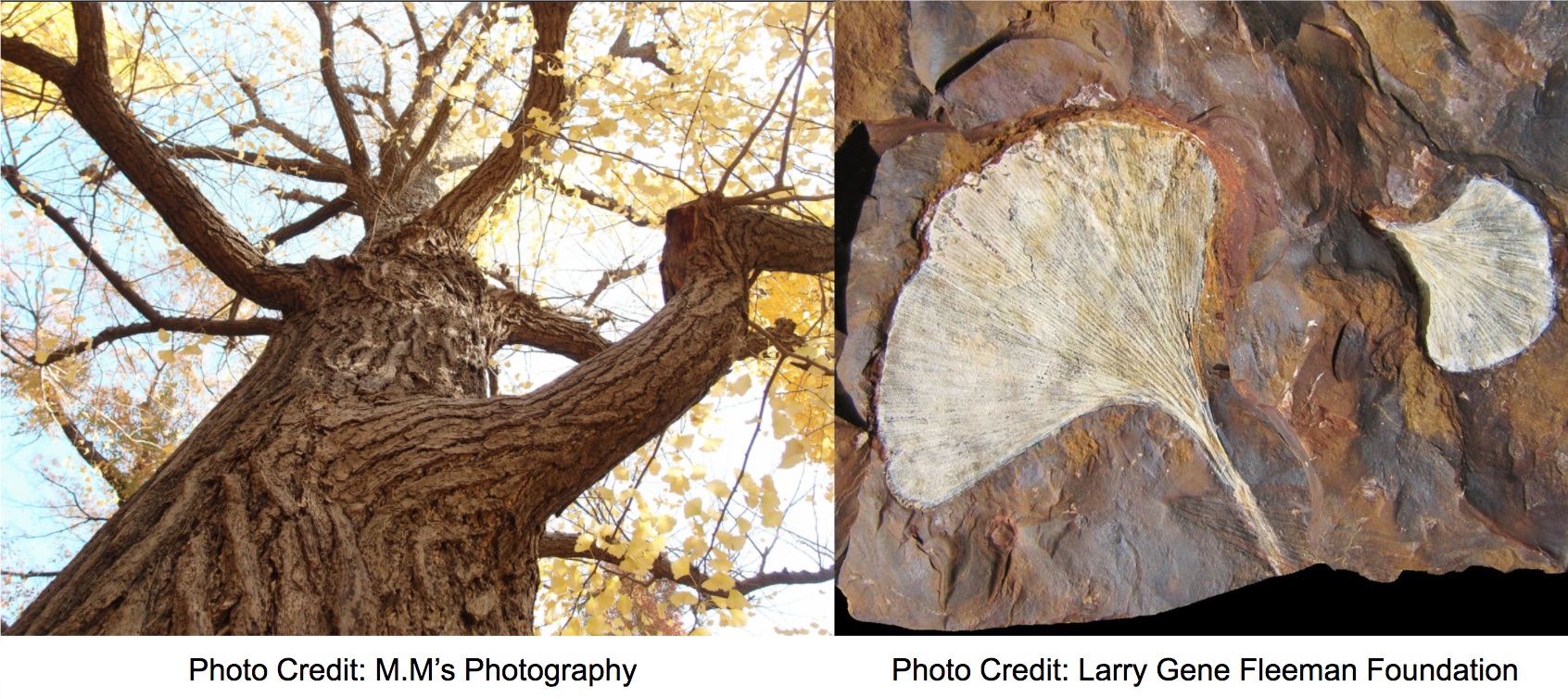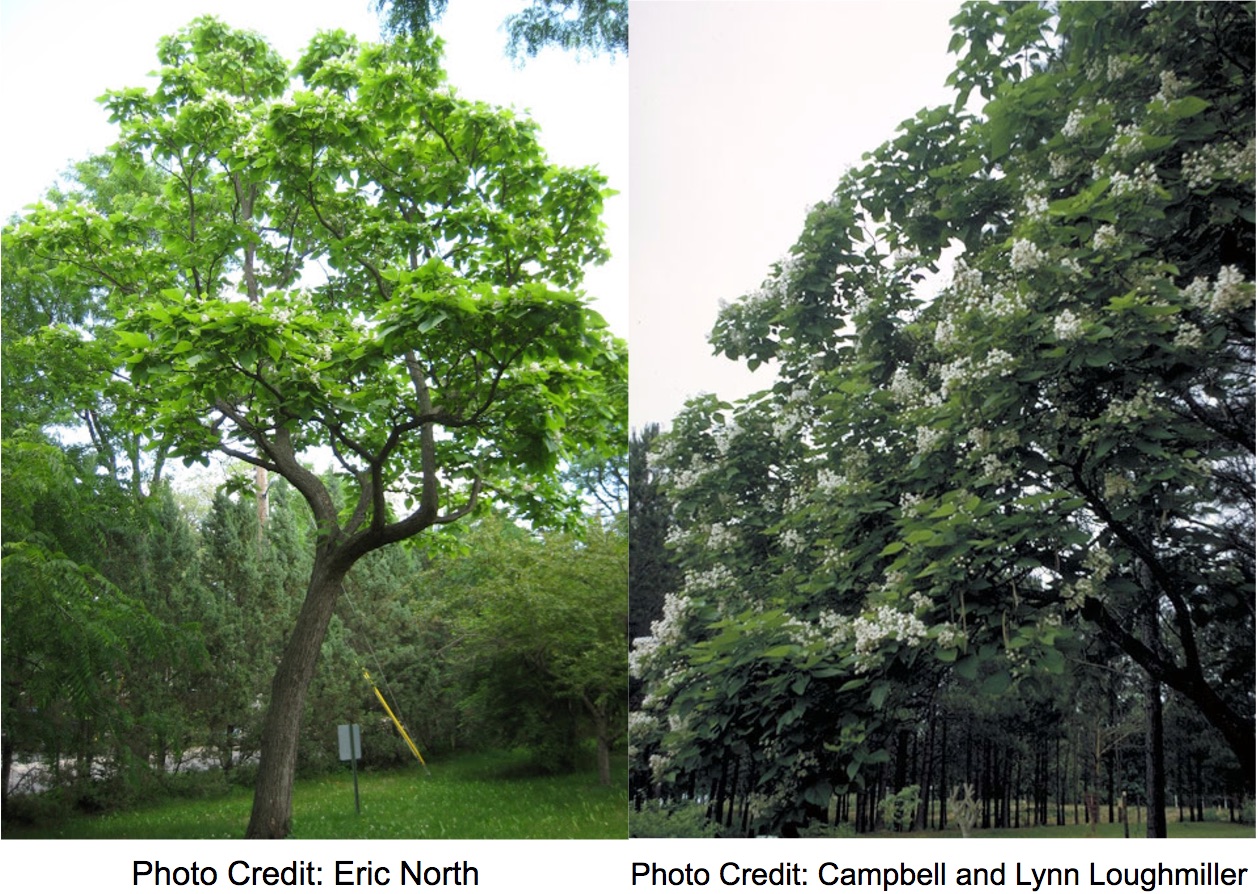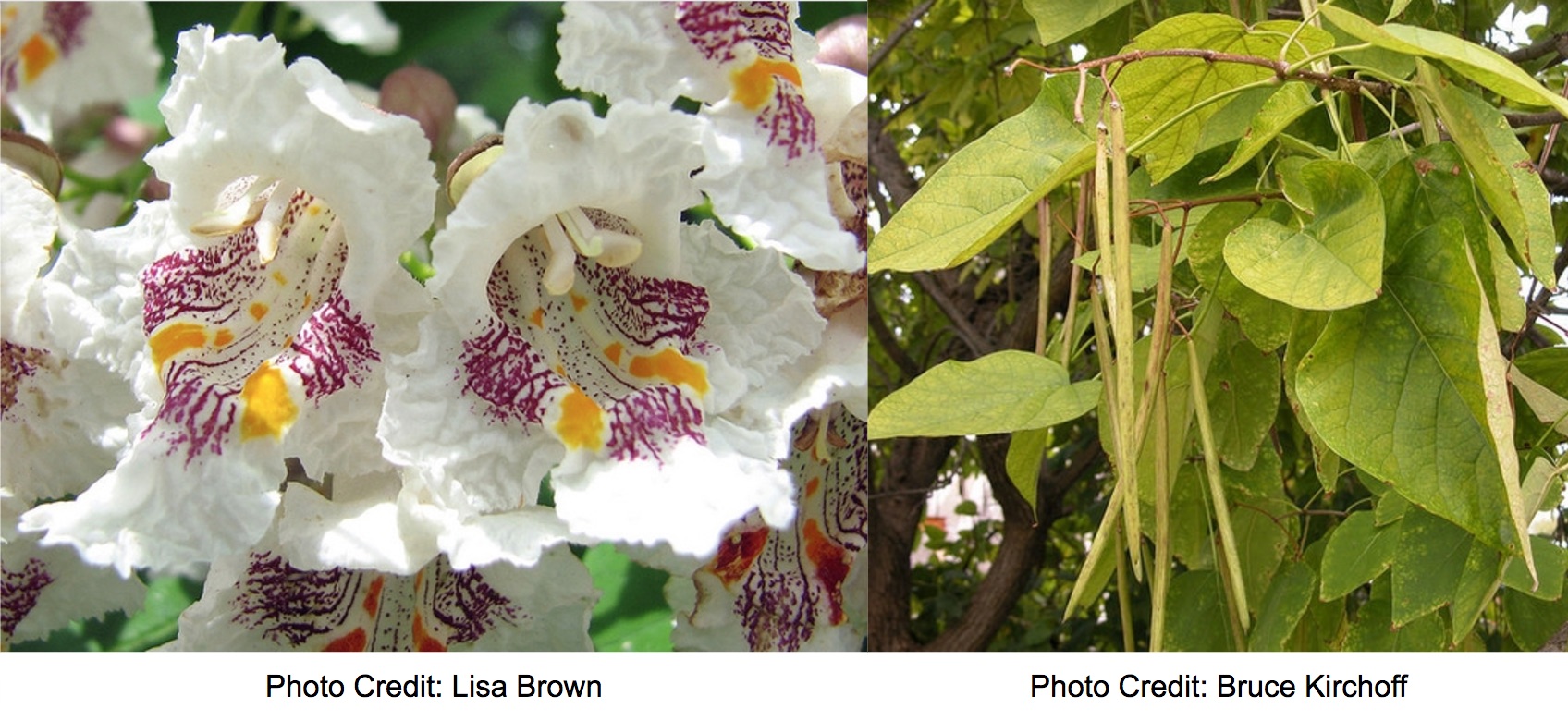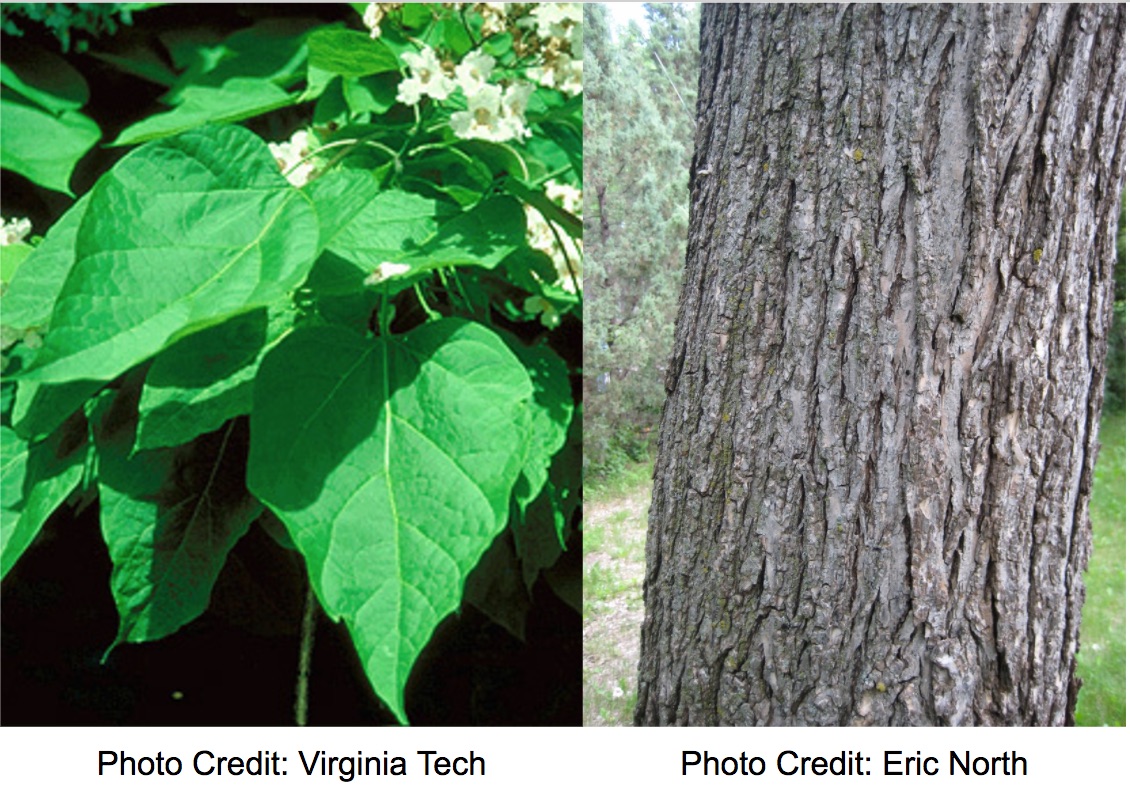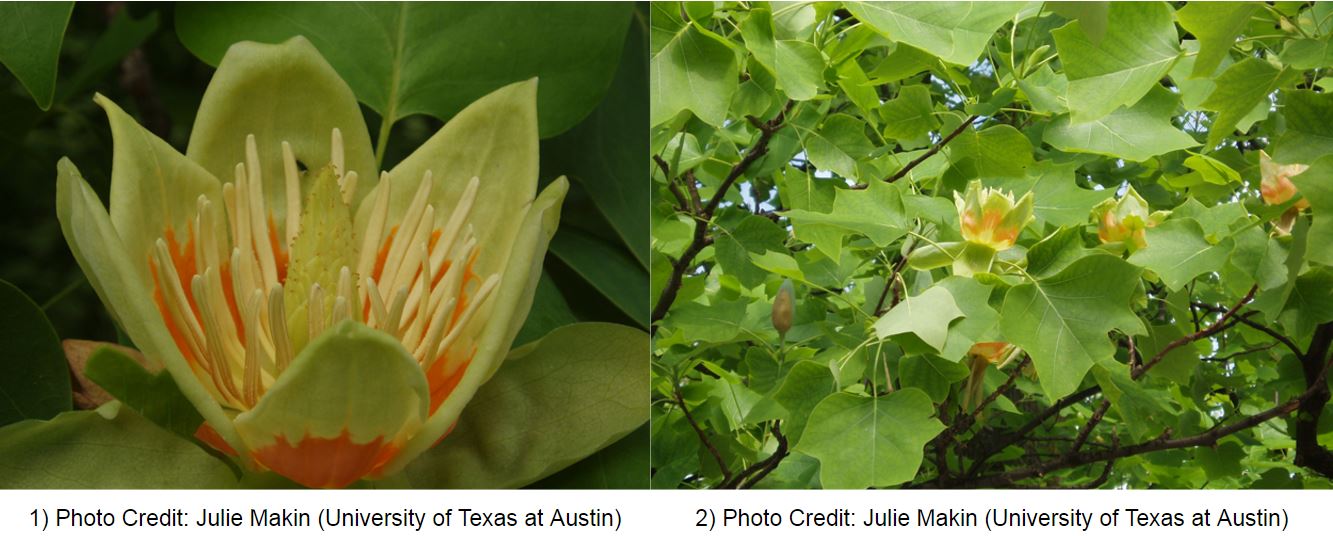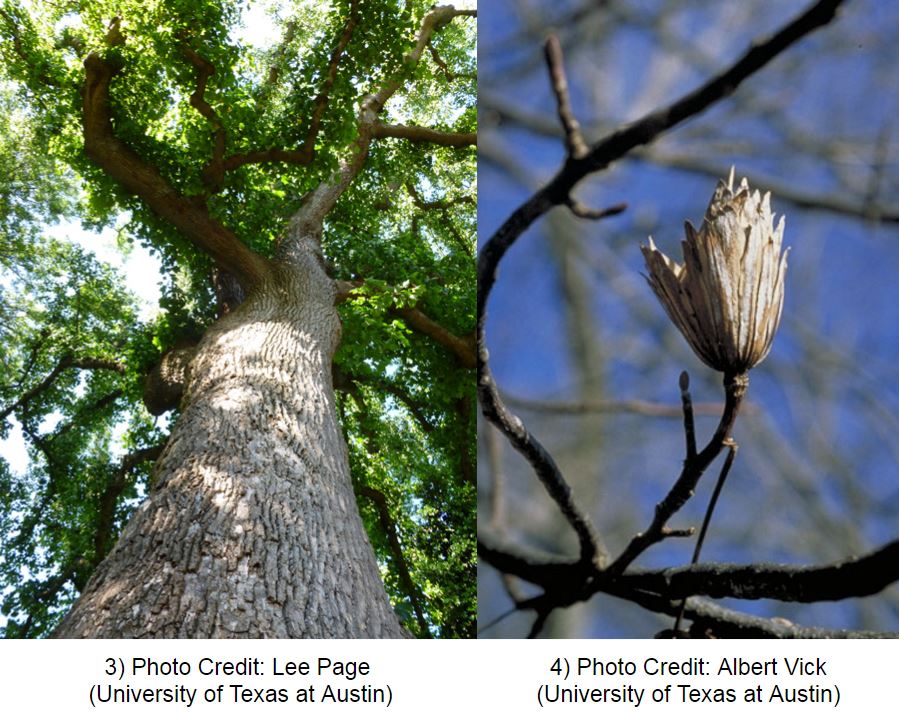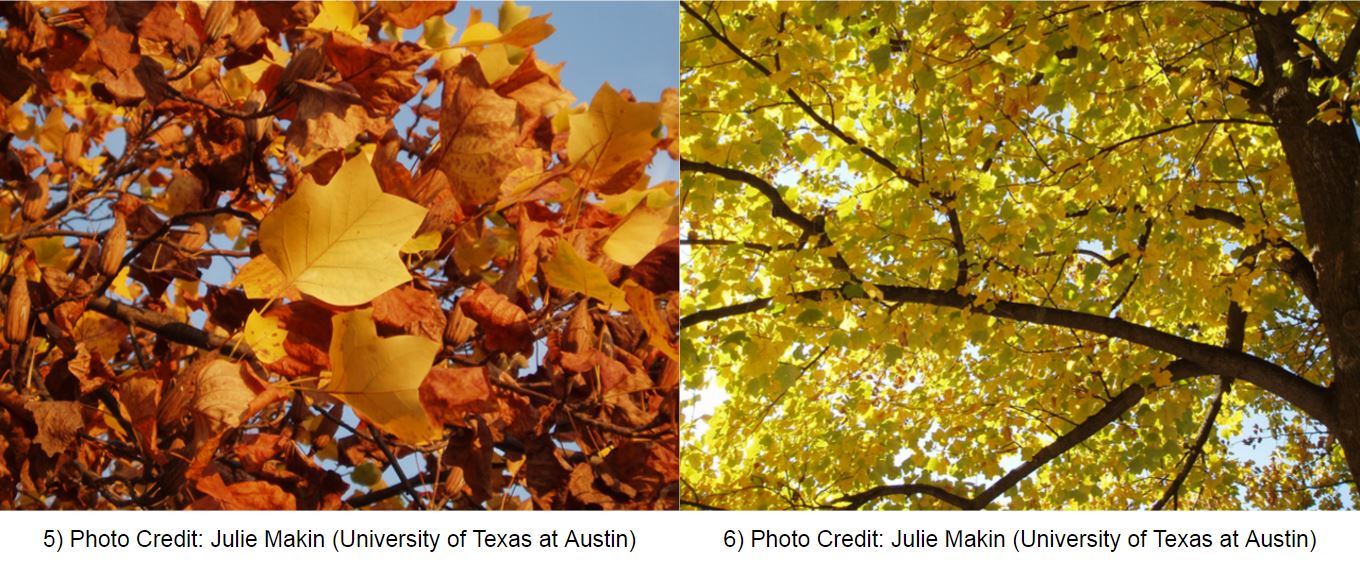Featured Tree: Eastern Redbud (Cercis canadensis)
By: Nick Schreiber
Nothing says spring like flowers in Minnesota. If you’re looking for a tree to flourish with flowers come spring, Eastern redbud, Cercis canadensis, is a fantastic choice for your front yard. Its diminutive stature, up to 35 feet tall, allows for placement in even small yards and in ones with power lines going over them. Its cold hardiness zones are 4-9. Since Minnesota is the northern limit of its range in the Midwest, Eastern redbud should be planted in the southern half of state. Cold hardy varieties or genotypes are preferable in Minnesota. The tree has been known to survive as far north as Grand Rapids, Minnesota.
Eastern redbud is an ornamental tree with heart shaped leaves. Bark appears reddish-brown to brown giving it a distinctive appearance particularly in the winter. Spring flowers are dark pink to purple. Flowers appear before leaves starting in early April. After pollination, pea pods 1 to 3 inches form. Birds, squirrels and other mammals feed on the seeds. In the fall, the leaves turn a brilliant yellow
Eastern redbud prefers light shade to full sun. Moist, well-drained soils result in the best growth.
Very wet or dry and hot locations are not suitable. Therefore, heavy clay soils that are poorly drained should be avoided as well as southern and western aspects.
Eastern redbud is generally short lived tree, living 50 to 70 years. The tree is prone to cankers that can disfigure the tree and Verticillium wilt, a fungal disease.
These diseases can shorten the tree’s lifespan. Adequate sunlight and moisture can prevent such diseases.
All photos and references are used for educational purposes only.
References
1) Andy David. Associate Professor and interim Director of Operations for the Cloquet Forestry Center and Hubachek Wilderness Research Center University of Minnesota. Personal Communication, August 2016.
2) Arbor Day Foundation. “Eastern Redbud.” 2016. http://bit.ly/2rj3Da0
3) Lake Forest College. “Cercis canadensis (Redbud) Fabaceae (Leguminosae).” http://bit.ly/2rvQJBM
4) University of Florida IFAS Extension. “Cercis canadensis: Eastern Redbud.” http://bit.ly/2pxbkox
5) Mark H. Brand. “Eastern Redbud.” 2015. University of Connecticut. http://bit.ly/2rvJmdW
Photos
1) Mark H. Brand. University of Connecticut. http://hort.uconn.edu/plantPhotos/cercan13.jpg
2) Mark H. Brand. University of Connecticut. http://hort.uconn.edu/plantPhotos/cercan01.jpg
3) Mark H. Brand. University of Connecticut. http://hort.uconn.edu/plantPhotos/cercan81.jpg
Amur Cork Tree (Phellodendron amurense)
By: Nick Perry
In today’s urban forest, a person is likely to come across a variety of tree species ranging from native to neo-native, and even introduced species from around the world. Urban trees are selected for a vast array of reasons ranging from their adaptability to urban conditions, their unique features such as bark or flowers, or even their rate of growth which allows for quicker landscaping results. Often times, these urban trees perform to their potential and become beneficial aspects of the urban environment. In certain circumstances, however, a tree species may overwhelmingly outperform surrounding species and become an issue rather than a benefit. The amur corktree, Phellodendron amurense, falls into this unique category of urban trees. While still being planted throughout the United States, several states have placed it on their invasive species list and people cannot plant or sell its stock.
This week’s tree of the week is certainly a “corky” tree, pun-intended. The name Phellodendron is derived from the unique bark of the tree. In Greek, the term “Phello” refers to cork and “dendron” refers to tree. On young branches, bark begins as yellowish-gray in color and changes to brown upon maturity. As the trunk matures, it develops deep, furrowed crevices that are grayish-brown in color. Both branches and mature bark have a spongy, corky feel to them. The growth habit of a mature tree produces a well-rounded canopy that is made up of a few horizontal branches developing from a short trunk. The height and spread of the tree ranges from 35’ to 50’ and growth rate is average. The branches give rise to the compound leaves, of which each typically contain 5-11(13) leaflets. The leaflets are arranged opposite along the rachis and are pinnately compound. They are typically 10”-15” long and are ovate to lance-ovate in shape. The leaf color changes from a nice, dark green in the summer to a yellow-bronze color in the fall.
Introduced into the United States around 1856, this tree is native to Northern China, Japan and Manchuria. By the early 1900’s, it was being planted throughout the northeastern portion of United States and was used in boulevards, parks and residential yards. In time, the tree became so adapted to its new environment that it became naturalized in surrounding forested areas where it remains to this day. Its ability to outcompete native vegetation affects the natural forest regeneration, leading to an unhealthier ecosystem. Forests that once were dominated by oaks, hickories and native shrubs are now being overrun by the corktree. The corktree berries are less nutritious than the nuts produced by the oaks and hickories, affecting the local wildlife as well.
The fact that the corktree is dioecious may be the reasoning behind why it is allowed in certain states while being banned in others. In short, the term dioecious refers to the way a tree reproduces. In dioecious species, the male and female flowers are found on separate plants. Only female flowers produce fruit containing seeds needed for regeneration. By planting only male trees, the possibility of seeds being produced and distributed is eliminated. Distribution of seeds can occur in a multitude of ways, but corktree seeds are generally distributed by birds eating the berries and by nearby waterways. In states where the tree is considered invasive, no past restrictions were placed on the female varieties. This meant that female trees planted produced berries containing seeds that were prominently spread and the subsequent seedlings outgrew the native vegetation.
The corktree is suitable for growth in Zones 3b to 7. It can withstand a variety of soil conditions from acidic to alkaline, and can handle drought and polluted air. Though the tree has been and still is grown along roadways, it may not be as hardy as once thought. The shallow, wide-spreading fibrous root system is best suited for larger landscapes such as parks or large residential yards. If the amur corktree is to be planted, check with local, regional or state forestry programs to inquire about the potential restrictions of its use. Many male varieties have been cultivated over the years to allow their continuance in the landscape. His Majesty is a male variety developed at the University of Minnesota and introduced in 1996.
All photos and references are used for educational purposes only.
References
- Dirr, Michael. Manual of Woody Landscape Plants. Champaign: Stipes Publishing L.L.C., 1998. Print.
- Simons, Dani and Swearingen, Jil M. Plant Conservation Alliance’s Alien Plant Working Group Least Wanted: Amur Corktree. Plant Conservation Alliance, Alien Plant Working Group, 07 Jul. 2009, https://www.nps.gov/plants/alien/fact/pham1.htm. Accessed 20 Feb. 2017.
Photos
- Backes, Carl, and Peggy Backes. Bark of Amur Cork Tree. Digital image. Flickr. Flickr, 15 July 2010. Web. 3 Mar. 2017. <http://bit.ly/2mOHmMf>.
- Grandmont, Jean-Pol. Phellodendron Amurense in August. Digital image. Wikimedia Commons. Wikimedia Commons, 26 Aug. 2007. Web. 3 Mar. 2017. <http://bit.ly/2mUV7rU>.
- M, James. Fruit of the Amur Cork-tree (Phellodendron Amurense). Digital image. Flickr. Flickr, 18 Aug. 2011. Web. 3 Mar. 2017. <http://bit.ly/2mOtkKy>.
- Missouri Botanical Garden. Phellodendron Amurense. Digital image. Missouri Botanical Garden Plant Finder. Missouri Botanical Garden, n.d. Web. 3 Mar. 2017. <http://bit.ly/2ln2ITV>.
- Oregon State University. Phellodendron amurense in the Autumn. Digital image. College of Agricultural Sciences - Department of Horticulture Landscape Plants. Oregon State University, n.d. Web. 3 Mar. 2017. <http://bit.ly/2mOBYbJ>.
Featured Tree: Ginkgo (Ginkgo biloba)
By: Natalie Hamilton
Ginkgo biloba, commonly known as the ginkgo tree or the maidenhair tree, can be incredibly beautiful to see in an urban setting. Their unique fan shaped foliage, bright yellow autumn colors, and mature spreading branches immediately make them stand out from other common trees. Although this slow- to medium-growing tree is native to China, it performs very well in the Midwestern climate, which has made it a more common species to see in Minnesota.
Ginkgo trees will grow 50-80 feet high, are tolerant of a variety of harsh site conditions, are disease and pest free, and are long lived. For these reasons, the ginkgo is commonly planted as a dependable boulevard or shade tree. These trees are also planted as ornamental trees because of the uncommon characteristics they display. Ginkgos produce unique branch spurs from which their bright green fan-shaped leaves grow from. These spurs, along with their textured light grey and brown wood, make ginkgos interesting to see even in the winter months when their leaves are absent.
Female ginkgo trees produce seeds with fleshy coverings. When those fleshy coverings begin to ripen in the autumn, they produce a foul and pungent scent, which is often compared to the smell of dog feces. Because of this undesirable characteristic, male selections of ginkgo are more often commercially sold. The only issue with this is that a ginkgo tree can actually take decades to express its sexual maturity. Occasionaly ginkgo trees will begin to produce seeds even though they were sold as males. This is because they were mis identified when they were sold and are actually female trees.
A living Fossil: Fossilized ginkgo leaves have been found that date back to an astounding 270 million years ago. Modern-day ginkgo leaves look almost unchanged compared to those of their ancient ancestors. This gives them the fitting nick name of being true living fossils.
All photos and references are used for educational purposes only
References
- Chase, Jeri. "The Ginkgo - a True “living Fossil” (GINKGO BILOBA)." Forests for Oregon 2007: 17-19. Print.
- Koetter, Rebecca, and Kathy Zuzek. "Ginkgo (Ginkgo Biloba)." University of Minnesota Garden Extension. University of Minnesota, 2016. Web. 17 Feb. 2017. <http://bit.ly/2lWFxMW>.
- "Ginkgo – Ginkgo Biloba." The University of Alabama Arboretum. The University of Alabama, n.d. Web. 17 Feb. 2017. <http://bit.ly/2ltePhr>.
- "Ginkgo Biloba." Missouri Botanical Garden: Plant Finder. Missouri Botanical Garden, n.d. Web. 17 Feb. 2017. <http://bit.ly/2m5w7Ol>.
Photos
- Blu, Nimar. Ginkgos on the Hokkaido University Campus. Digital image. Inhokkaido. N.p., 28 Oct. 2014. Web. 15 Feb. 2017. <http://bit.ly/2l3GR24>.
- Ginkgo leaf attachment. Digital image. Tree of the Week Theme: Cold Weather Champions. Wercester Tree Initiative, 26 Sept. 2016. Web. 17 Feb. 2017. <http://bit.ly/2lfTOnR>.
- Ramsey, Derek. Ginkgo Tree Ginkgo Biloba Fallen Leaves. Digital image. Wikimedia Commons. Wikimedia Commons, 23 Nov. 2007. Web. 17 Feb. 2017. <http://bit.ly/2kyehqV>.
- Suchak, Sanjay. UVA’s Pratt Ginkgo. Digital image. UVA Today. University of Virginia, 17 Dec. 2015. Web. 17 Feb. 2017. <http://bit.ly/2l3ESKR>.
- M.M's Photography. Ginkgo. Digital image. Flickr, 2 Dec. 2013. Web. 17 Feb. 2017. <http://bit.ly/2ky5Bko>.
- Fossil Ginkgo Leaves. Digital image. Fossil Ginkgo Leaves- Sentinel Butte Formation, Morton County, North Dakota. Larry Gene Fleeman Foundation, 2 Dec. 2013. Web. 17 Feb. 2017. <http://bit.ly/2kHZQvI>.
- Aomorikuma. Ginkgo (Japan). Digital image. Wikimedia Commons. Wikimedia Commons, 3 Nov. 2007. Web. 17 Feb. 2017. <http://bit.ly/2m5AqJh>.
- Kolasiński, Marcin. Maidenhair tree - male flower. Digital image. Wikimedia Commons. Wikimedia Commons, 28 Apr. 2010. Web. 17 Feb. 2017. <http://bit.ly/2kSAUSV>.
Northern Catalpa (Catalpa speciosa)
By: Brianna Egge
Catalpa speciosa, commonly referred to as northern catalpa, or simply catalpa. Northern catalpa is a medium to large deciduous tree native to the United States that survives in USDA Hardiness zones of 4-8. This means that northern catalpa can survive throughout most of the chillier Midwestern states. These trees usually grow to around 40-70 feet, with some known to reach 100 feet tall, and have a canopy spread of about 20-50 feet. They prefer full sun to partial shade areas with well-drained soils, but are tolerant of many soil conditions, including seasonal flooding. These trees are also tolerant to deer, drought, clay soils, and air pollution, which may make these trees ideal for withstanding city conditions.
Northern catalpa grow rapidly. The trunk is usually short and often crooked. It supports an irregular, rounded crown with narrow spreading branches and thick twigs. The bark is typically grey to reddish-brown and has irregular shallow fissures. The broad, elongated cordate leaves reach lengths of 12” long and have pointed tips. The light green leaves turn a bright yellow color in the fall. The white showy, bell-shaped flowers have yellow and purple spottings on the inside and are about 2” long. After blooming in late spring, these flowers give way to long (12-22”) green seedpods. The seedpods mature and turn a dark brown color in the fall before splitting open to release the contained seeds in spring. These pods are how northern catalpa received the name ‘cigar tree’. These seedpods are produced in large quantities every 2-3 years and persist through the winter season.
Northern catalpa may prove to be a popular urban tree planting for its beautiful showy flowers, large heart-shaped leaves, and unique crown form. It can also tolerate a wide array of conditions that would make it suitable to urban areas.
All photos and references are used for educational purposes only
References
- Missouri Botanical Garden. “Catalpa speciosa.” N.p., n.d. Web. 7 Feb. 2017 <http://bit.ly/22AfppD>
- Arbor Day Foundation. “Northern Catalpa: Catalpa speciosa.” N.p., 2016. Web. 7 Feb. 2017. <http://bit.ly/2lkDv87>
- Lady Bird Johnson Wildflower Center. “Catalpa speciosa.” University of Texas, 18 May 2016. Web. 7 Feb. 2017. <http://bit.ly/2jZ2FYJ>
- ISU Forestry Extension. “Catalpa (Catalpa speciosa).” Trees of Iowa: An Interactive Key. Iowa State University, 16 Aug. 2015. Web. 7 Feb. 2017. <http://bit.ly/2kiF0ni>
Photos
- North, Eric. Catalpa speciosa form. Digital image. UFORE Lab & Nursery. University of Minnesota, n.d. Web. 10 Feb. 2017. <http://bit.ly/2kvKHOu>.
Loughmiller, Campbell, and Lynn Loughmiller. Catalpa speciosa. Digital image. Lady Bird Johnson Wildflower Center. University of Texas at Austin, 03 May 1999. Web. 10 Feb. 2017. <http://bit.ly/2kJRc3S>.
Brown, Lisa. Catalpa Speciosa. Digital image. North Carolina State University A&T Cooperative Extension. North Carolina State University, n.d. Web. 10 Feb. 2017. <http://bit.ly/2lh94DT>.
Kirchoff, Bruce. Catalpa Speciosa. Digital image. North Carolina State University A&T Cooperative Extension. North Carolina State University, n.d. Web. 10 Feb. 2017. <http://bit.ly/2lh94DT>.
Virginia Tech. Northern Catalpa. Digital image. Department of Forest Resources and Environmental Conservation. Virginia Tech, n.d. Web. 10 Feb. 2017. <http://bit.ly/2jYTesg>.
North, Eric. Catalpa speciosa Bark. Digital image. UFORE Lab & Nursery. University of Minnesota, n.d. Web. 10 Feb. 2017. <http://bit.ly/2kvKHOu>
Tulip Poplar (Liriodendron tulipifera)
By: Nick Schreiber
If you are a Minnesotan looking for a unique tree to plant in your yard, tulip poplar, Liriodendron tulipifera, is a great choice. With brilliant, yellow fall colors and showy, yellow-green flowers, tulip poplar is guaranteed to impress your neighbors. While it is not native to Minnesota, it can grow in the southern half of the state. Its cold hardiness zones are 4-9.
Tulip poplar is considered an ornamental and shade tree. It can be planted in yards or as a boulevard tree. It is a very straight tree with a mature height ranging between 70-90 feet and a mature crown spread of 40 feet. The bark is light gray and becomes vertically fissured with age. It can grow in soils that are not extremely dry or wet and low in nutrients. It grows well in loamy, acidic, moist, well-drained and clay soils. Full sun, at least six hours a day, is ideal for tulip poplar growth. In optimal conditions, it can grow 24 inches per year or more. However, since tulip poplar is at the northern extent of its range in Minnesota, it will likely not grow more than 24 inches per year.
No other tree in Minnesota have leaves like the tulip poplar. It has unique 3-6 inch lobed leaves. A shallow v-notch on the end of the leaf gives the leaf its distinctive appearance. Leaves usually have 4-6 pointed lobes. Not only is the tree pleasing to the eye, but it is a valuable food source for wildlife. White tail deer and rabbits browse young trees in the fall and winter. In the spring, ruby-throated hummingbirds drink nectar from its flowers. Mature seeds provide sustenance for mammals and birds throughout the summer into the winter.
Since Minnesota is on the northern edge of tulip poplar’s range, care should be taken when planting it. In order to reduce or prevent winter damage, the tree should not be planted on northern exposures that receive little sun nor in areas that are very windy. On young trees, coarse woody mulch can be applied around the tree base in the late fall in order to reduce the chance of root injury due to extreme cold. Once spring arrives, the mulch should be removed. As Minnesota winters have shown a warming trend, tulip trees will be another possible option to plant in the upper mid west.
References
Arbor Day Foundation. “Tuliptree.” 2016. http://bit.ly/2k4Iaeg
United States Department of Agriculture. “Minnesota Forest Ecosystem Vulnerability Assessment and Synthesis: A Report from the Northwoods Climate Change Response Framework.” 2014. http://bit.ly/2jM3PqE
U.S. Forest Service. “Yellow-Poplar.”n.d. http://bit.ly/2jHIqDT
Photos
- Makin, Julie. Liriodendron Tulipifera L. Digital image. Lady Bird Johnson Wildflower Center. The University of Texas at Austin, 26 Mar. 2014. Web. 3 Feb. 2017. <http://bit.ly/2k53aRZ>.
- Makin, Julie. Liriodendron Tulipifera L. Digital image. Lady Bird Johnson Wildflower Center. The University of Texas at Austin, 31 Jan. 2012. Web. 3 Feb. 2017. <http://bit.ly/2kBKkFj>.
- Page, Lee. Liriodendron Tulipifera L. Digital image. Lady Bird Johnson Wildflower Center. The University of Texas at Austin, 14 June 2012. Web. 3 Feb. 2017. <http://bit.ly/2l1zsS5>.
- Vick, Albert F.W. Liriodendron Tulipifera L. Digital image. Lady Bird Johnson Wildflower Center. The University of Texas at Austin, 25 Sept. 1990. Web. 3 Feb. 2017. <http://bit.ly/2kqoyCb>.
- Makin, Julie. Liriodendron Tulipifera L. Digital image. Lady Bird Johnson Wildflower Center. The University of Texas at Austin, 27 June 2013. Web. 3 Feb. 2017. <http://bit.ly/2l1txfR>.
- Makin, Julie. Liriodendron Tulipifera L. Digital image. Lady Bird Johnson Wildflower Center. The University of Texas at Austin, 31 Jan. 2012. Web. 3 Feb. 2017. <http://bit.ly/2l1uhkQ>.

